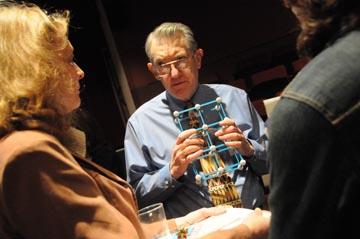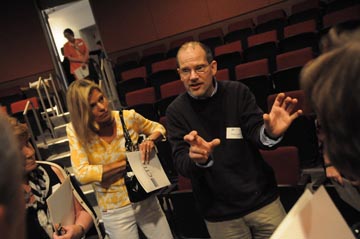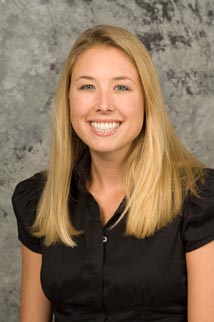An article from the summer 2010 issue of Exchange magazine
 It is 6 p.m. on a chilly Thursday night in October, and after finishing their pizza, students are gathered around a worktable, playing with what looks to be an erector set. The group, chattering happily and sharing pieces to help create the best structure, is not comprised of just any students. These students are teachers, too, and they are playing in a sense, but they are also learning. And they are learning how to teach better.
It is 6 p.m. on a chilly Thursday night in October, and after finishing their pizza, students are gathered around a worktable, playing with what looks to be an erector set. The group, chattering happily and sharing pieces to help create the best structure, is not comprised of just any students. These students are teachers, too, and they are playing in a sense, but they are also learning. And they are learning how to teach better.
The erector set? That is not what it seems, either, says UNC Charlotte mathematics professor Harold Reiter. It is actually a design tool for teaching solid geometry, science, art, engineering and architecture. In this classroom, Reiter uses an assortment of “toys” to inspire his students to think about mathematical problems in new ways.
“We should all spend some time playing with mathematics, and it should not be restricted to a formal exercise,” says Reiter. “An exercise is a math problem you’ve been taught how to do. A problem is a math challenge you don’t know how to solve. We would like students to spend more time on problems than exercises.”
These students are Charlotte-Mecklenburg Schools (CMS) mathematics teachers, from elementary through high school, and while they already know how to teach well, they are learning new ways to teach students to think deeply about mathematical problems. And, beyond that, they are just learning and playing with math for the fun of it.
“Because when teachers become passionate about a subject,” says Molly Shaw, director of the new Charlotte Teachers Institute (CTI), a partnership among CMS, UNC Charlotte, and Davidson College, “They pass that passion along to their students.”
CTI, the first initiative of its kind in the state of North Carolina, is based on the Teachers Institute approach begun over 30 years ago by the Yale National Initiative in New Haven, Connecticut and since executed in cities around the country.
CTI focuses on building a teacher’s knowledge base rather than addressing methods and pedagogy. The interdisciplinary seminars give CMS teachers the opportunity to study subjects that both interest them and relate to their classroom teaching. The seminar participants, referred to as CTI Fellows, attend 13 once-a-week, two hour seminars taught by a college faculty member from August until November, and write a new curriculum unit for their students based on that experience. They receive a $1,500 stipend for successfully completing the program.
“While each CTI Fellow in a seminar will study the same topic, it’s up to them individually to figure out how to implement in the classroom what they have learned,” explains Shaw.
UNC Charlotte’s College of Liberal Arts and Sciences – along with partners CMS and Davidson – is contributing both personnel and financial resources for the program. Shaw is seeking foundation and private support to expand the program to reach more of the school system’s 10,000 teachers.
“Not An Ordinary Course”

While mathematics teachers are building their polyhedra in Reiter’s class, elsewhere on UNC Charlotte’s campus, an unlikely mix of social studies, language arts, psychology and art teachers from all grades are gathering to learn about “Children in War and Conflict” from the history department’s senior lecturer and director of undergraduate and honors studies, Oscar Lansen. With a passion that his students have come to accept as his default setting when he gets rolling on the topic, Lansen talks about how children are affected by war across history and across the globe. From discussions of Hitler’s Youth, to Rwandan child soldiers, to gang members in Charlotte, Lansen says he is teaching the important lessons of the impact of conflict through the lens of the child.
That is one thing that appealed to Dana DiPerna Pillsbury, a ninth grade English teacher at North Mecklenburg High School.
“I am passionate about showing my students perspectives from children their age,” says Pillsbury. “I planned my year around the unit.”
“By using the child’s eye you can teach so much better the difficult, inaccessible lessons of history,” says Lansen. “And while it is often true that young students don’t necessarily see the significance of historical connections, we can help them become true analysts of history.”
While Lansen acknowledges that one of his primary roles is to instill with the teachers a good amount of content knowledge on the subject, he also recognizes that this is different than a strict lecture course.
“This is not an ordinary course,” says Lansen. “To me learning is a continuous process. Although we necessarily spent time on content knowledge in class, I met with most of my students individually two or three times outside of class to discuss the topics and develop their lesson plans.”
“This was different from a regular course because of the collaborative element,” said Pillsbury. “It is very collegial. You are actually investing yourself in the course.”
Translating a Lesson into a Lesson Plan
Both Reiter and Lansen get excited when talking about the lesson plans that their teacher-students developed by the end of the semester. Reiter describes one project by Randolph Middle School mathematics teacher Michael Pillsbury.
“He made a presentation one night on a topic called ‘Rational Tangles,’” says Reiter. “It is a way of associating knots with a rational number. You twist the rope up into a big knot, and then Michael will tell you the value of this knot. Then he’ll say ‘this is how you undo the knot,’ through a mathematical process. And it works every time! He gave this talk at Elon University, and they told him it was the best talk the students had ever had.”
Lansen says that the teachers in his class “knocked his socks off” with their final units. Elizabeth Lasure, an art history and studio art teacher at Mallard Creek High School, in particular, did the seemingly impossible by creating a lesson plan for art students from the Children in War and Conflict class, which is more conducive to history and literature lessons. Her lesson called for students to study the images of war, be it propaganda posters or gang grafitti, and consider the motivation behind how art is used in situations like conflict. Students were then asked to create works that reflect a personal style and awareness of the power of art to illuminate, inform, and influence opinion.
“I developed my unit with the intention of providing an opportunity for my students to learn from their peers and make history applicable,” says Lasure.
Influencing 4000 Students
Shaw says that in the four courses offered last fall (two at UNC Charlotte and two at Davidson) 50 CMS teachers were enrolled, and a total of 4,000 of their students were directly influenced by the lesson plans that their teachers took away from their seminars. Twice that many teachers and students will be involved this year, as CTI expands its offerings from four to eight courses.
The courses that will be taught this fall include:
- Exploring the Solar System
- Redefining Modernism Through the Collection of the Bechtler Museum of Modern Art
- Environmental Sustainability: Science, Society and Solutions
- Mathematics in Art
- The Rise of the New South
- How Languages Are Learned and How Best to Teach Them
- Gender, Race and Justice
- Writing for Your Life
All seminar topics are selected by CMS teachers. In addition to choosing topics, CMS teachers serve in a number of CTI leadership roles: they recruit and select seminar participants, help faculty prepare for and facilitate seminars, and work side-by-side with Shaw on a number of projects.
“That is what makes CTI different,” says Shaw, “It is driven by the needs of teachers, led and administered by teachers – a real collaborative effort and one that develops the whole person. This is not only a professional development opportunity for teachers but a leadership opportunity as well. That’s what makes it such a rich experience.”
Expanding Minds with “Exploding Canons”
A sidenote by CTI Director Molly Shaw

A new priority for CTI is the expansion of our educational opportunities into the local community. We are connected to an outstanding wealth of faculty experts, thanks to our partnership with UNC Charlotte and Davidson College, and we are bringing this expertise into more CMS classrooms and into the broader Charlotte community with our new Exploding Canons series.
The first Exploding Canons event, which took place last February at the new Bechtler Museum in uptown Charlotte, featured five faculty members speaking about the topic of disease. Over 150 people attended, with more than half from CMS. Throughout the evening, the presenters discussed disease as it relates to human biological history, race and imperialism, racism and nationalism, and disability studies. From UNC Charlotte, the panel included history professor and department chair Jurgen Buchenau, speaking on “How Disease Shaped the Americas,” and education associate professor Charles Hutchison speaking on “The Effects and Diagnosis of ‘Dis-ease’ in School and Society.”
Exploding Canons offers a unique approach to community dialogue. CMS teachers choose each topic, and expert faculty unveil unexpected ideas and challenge traditional thought.
CTI has great plans to offer more community events in the Charlotte area. If you would like more information about future events, or if you have suggestions for topics, please contact me at MollyShaw@uncc.edu.








